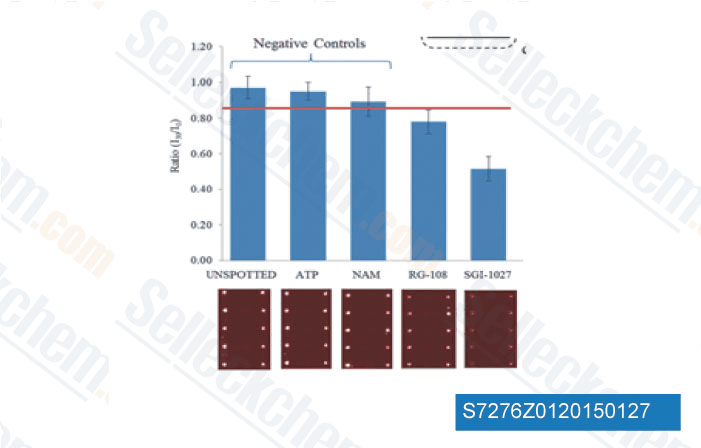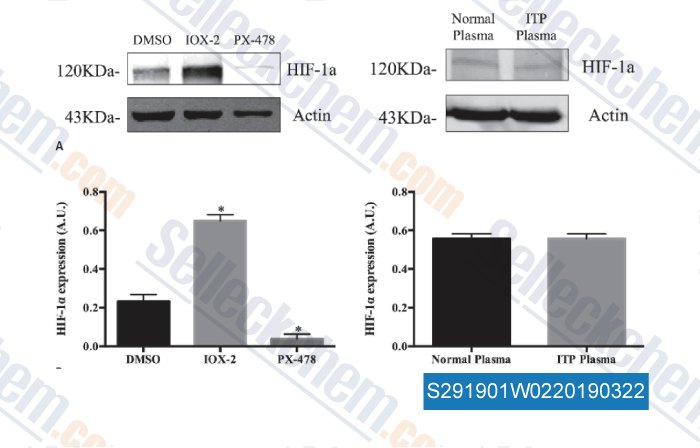|
Toll Free: (877) 796-6397 -- USA and Canada only -- |
Fax: +1-832-582-8590 Orders: +1-832-582-8158 |
Tech Support: +1-832-582-8158 Ext:3 Please provide your Order Number in the email. |
Technical Data
| Formula | C27H23N7O |
|||
| Molecular Weight | 461.52 | CAS No. | 1020149-73-8 | |
| Solubility (25°C)* | In vitro | DMSO | 92 mg/mL (199.34 mM) | |
| Water | Insoluble | |||
| Ethanol | Insoluble | |||
|
* <1 mg/ml means slightly soluble or insoluble. * Please note that Selleck tests the solubility of all compounds in-house, and the actual solubility may differ slightly from published values. This is normal and is due to slight batch-to-batch variations. * Room temperature shipping (Stability testing shows this product can be shipped without any cooling measures.) |
||||
Preparing Stock Solutions
Biological Activity
| Description | SGI-1027 (DNA Methyltransferase Inhibitor II) is a DNMT inhibitor with IC50 of 6, 8, 7.5 μM for DNMT1, DNMT3A, and DNMT3B in cell-free assays, respectively. SGI‑1027 induces apoptosis. | ||||||
|---|---|---|---|---|---|---|---|
| Targets |
|
||||||
| In vitro | SGI-1027 inhibits DNA methylation by directly inhibiting DNMTs, and results in selective degradation of DNMT1 in a wide variety of human cancer cell lines. SGI-1027 exhibits minimal or no cytotoxic effect in rat hepatoma H4IIE cells. [1] SGI-1027 (0-100 μM) exhibits a moderate pro-apoptotic effect on U937 human leukemia cell line with no relevant changes on the cell cycle. [2] |
||||||
| In vivo | SGI-1027 (DNA Methyltransferase Inhibitor II) is a DNMT inhibitor . |
||||||
| Features | Potential for use in epigenetic cancer therapy. |
Protocol (from reference)
| Kinase Assay: |
|
|---|---|
| Cell Assay: |
|
| Animal Study: |
|
References
|
Customer Product Validation

-
Data from [Data independently produced by Lab Chip, 2014, 14(13), 2354-62]

-
Data from [Data independently produced by , , Oncol Lett, 2018, 16(5):5799-5806]
Selleck's SGI-1027 has been cited by 13 publications
| DNMT3B-mediated FAM111B methylation promotes papillary thyroid tumor glycolysis, growth and metastasis [ Int J Biol Sci, 2022, 18(11):4372-4387] | PubMed: 35864964 |
| Utilizing an Endogenous Progesterone Receptor Reporter Gene for Drug Screening and Mechanistic Study in Endometrial Cancer [ Cancers (Basel), 2022, 14(19)4883] | PubMed: 36230806 |
| Small molecule profiling to define synergistic EGFR inhibitor combinations in head and neck squamous cell carcinoma [ Head Neck, 2022, 44(5):1192-1205] | PubMed: 35224804 |
| Methionine Protects Mammary Cells against Oxidative Stress through Producing S-Adenosylmethionine to Maintain mTORC1 Signaling Activity [ Oxid Med Cell Longev, 2021, 2021:5550196] | PubMed: 34336098 |
| Effect of Naoluoxintong on the NogoA/RhoA/ROCK pathway by down-regulating DNA methylation in MCAO rats [ J Ethnopharmacol, 2021, 281:114559] | PubMed: 34461189 |
| Revisiting Aldehyde Oxidase Mediated Metabolism in Drug-like Molecules: An Improved Computational Model [ J Med Chem, 2020, 31] | PubMed: 32191458 |
| Prolonged unfolded protein reaction is involved in the induction of chronic myeloid leukemia cell death upon oprozomib treatment [ Cancer Sci, 2020, 112(1):133-143] | PubMed: 33067904 |
| Direct interaction of DNMT inhibitors to PrPC suppresses pathogenic process of prion. [ Acta Pharm Sin B, 2019, 9(5):952-959] | PubMed: 31649845 |
| Suppressing microRNA-29c promotes biliary atresia-related fibrosis by targeting DNMT3A and DNMT3B [ Cell Mol Biol Lett, 2019, 24:10] | PubMed: 30906331 |
| Epigenetic Reprogramming with Antisense Oligonucleotides Enhances the Effectiveness of Androgen Receptor Inhibition in Castration-Resistant Prostate Cancer [ Cancer Res, 2018, 78(20):5731-5740] | PubMed: 30135193 |
RETURN POLICY
Selleck Chemical’s Unconditional Return Policy ensures a smooth online shopping experience for our customers. If you are in any way unsatisfied with your purchase, you may return any item(s) within 7 days of receiving it. In the event of product quality issues, either protocol related or product related problems, you may return any item(s) within 365 days from the original purchase date. Please follow the instructions below when returning products.
SHIPPING AND STORAGE
Selleck products are transported at room temperature. If you receive the product at room temperature, please rest assured, the Selleck Quality Inspection Department has conducted experiments to verify that the normal temperature placement of one month will not affect the biological activity of powder products. After collecting, please store the product according to the requirements described in the datasheet. Most Selleck products are stable under the recommended conditions.
NOT FOR HUMAN, VETERINARY DIAGNOSTIC OR THERAPEUTIC USE.
